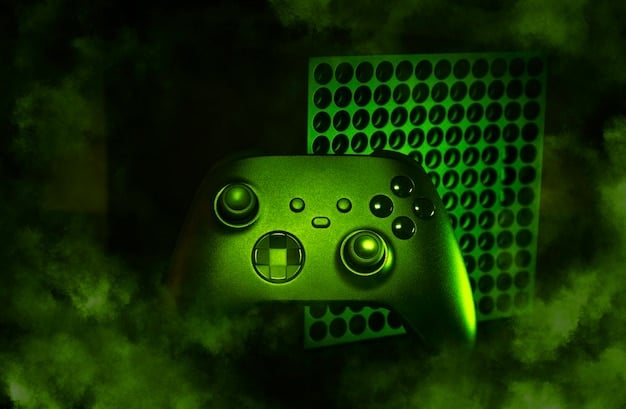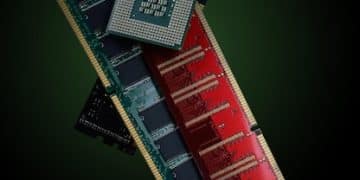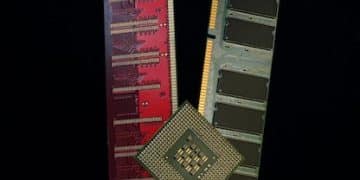NVIDIA vs AMD: A Gamer’s Guide to the Latest GPUs in the US

This article provides a competitive analysis of NVIDIA’s response to AMD’s latest GPUs, offering US gamers insights into performance, features, and value to help them make informed purchasing decisions.
For US gamers constantly seeking the ultimate visual experience, the battle between NVIDIA’s Response to AMD’s Latest GPUs: A Competitive Analysis for US Gamers is perpetually renewed. Understanding the nuances of each company’s offerings is crucial for building the perfect gaming rig.
The Evolving GPU Landscape for US Gamers
The graphics processing unit (GPU) market is fiercely competitive, with both NVIDIA and AMD constantly pushing the boundaries of performance and technology. For US gamers, this competition translates into more choices and better value. However, navigating the complexities of each company’s product lines can be daunting.
Understanding the current landscape requires examining the latest GPU releases, architectural innovations, and how these factors impact real-world gaming performance. Let’s delve into the key aspects of this evolving market.
Key Architectural Differences
NVIDIA and AMD employ different architectural approaches in their GPUs, leading to varying strengths and weaknesses. Understanding these differences is vital for making an informed decision.
NVIDIA leverages its Ampere and Ada Lovelace architectures, emphasizing ray tracing performance and AI-powered features like DLSS (Deep Learning Super Sampling). AMD, on the other hand, utilizes its RDNA 2 and RDNA 3 architectures, focusing on raw performance and value for money.
- NVIDIA’s Ray Tracing Focus: NVIDIA’s RTX series excels in ray tracing, a technology that simulates realistic lighting and shadows.
- AMD’s Raw Performance: AMD’s Radeon GPUs often deliver impressive raw performance, particularly in rasterization.
- DLSS vs. FSR: NVIDIA’s DLSS uses AI to upscale lower-resolution images, improving performance without sacrificing visual quality. AMD’s FSR (FidelityFX Super Resolution) offers a similar functionality, but uses a different approach.
Ultimately, the best architecture for you will depend on your specific gaming needs and preferences. If ray tracing is a priority, NVIDIA’s RTX cards are the clear choice. However, if you’re looking for the best value for money, AMD’s Radeon GPUs may be a better option.

In conclusion, as US gamers explore the GPU market, they are greeted with a dynamic playing field where NVIDIA and AMD battle for supremacy. It requires a deep dive into architectural differences, gaming performance metrics, and price-to-performance ratios for gamers to truly find the perfect GPU.
Comparing Performance: Benchmarks and Real-World Gaming
Benchmarks are essential for comparing the performance of different GPUs. However, it’s crucial to understand the limitations of benchmarks and consider real-world gaming performance.
Synthetic benchmarks like 3DMark provide a standardized way to test GPU performance, but they may not accurately reflect how a GPU performs in specific games. Real-world gaming benchmarks, on the other hand, offer a more realistic assessment of performance.
Analyzing Key Benchmarks
Several key benchmarks can help you compare the performance of NVIDIA and AMD GPUs.
These benchmarks include 3DMark Time Spy, 3DMark Fire Strike, and various game-specific benchmarks. Analyzing these results can provide valuable insights into the relative performance of different GPUs.
- 3DMark Time Spy: A DirectX 12 benchmark that tests GPU performance in modern gaming scenarios.
- Game-Specific Benchmarks: Benchmarks that measure performance in specific games, providing a more realistic assessment of performance.
- Frame Rates and Resolution: Pay attention to frame rates at different resolutions (1080p, 1440p, 4K) to determine which GPU is best for your monitor.
Remember to consider your specific gaming needs and preferences when analyzing benchmarks. If you primarily play older games, a less powerful GPU may be sufficient. However, if you’re looking to play the latest AAA titles at high resolutions and frame rates, you’ll need a more powerful GPU.
To wrap up, benchmarks and real-world gaming scenarios are two sides of the same coin when it comes to assessing GPU performance for US gamers. A balanced approach is vital, considering synthetic benchmarks alongside real-world game tests to ensure gamers choose a GPU that meets their gaming lifestyle.
Ray Tracing and DLSS: NVIDIA’s Competitive Edge?
Ray tracing and DLSS are two key technologies that give NVIDIA a competitive edge in the high-end GPU market.
Ray tracing simulates realistic lighting and shadows, adding a new level of visual fidelity to games. DLSS uses AI to upscale lower-resolution images, improving performance without sacrificing visual quality.
The Impact of Ray Tracing on Gaming
Ray tracing can significantly enhance the visual quality of games, but it also comes at a performance cost.
NVIDIA’s RTX series GPUs are specifically designed to handle ray tracing, thanks to their dedicated ray tracing cores. However, even with these dedicated cores, ray tracing can still impact performance.
- Visual Fidelity: Ray tracing creates more realistic lighting and shadows, enhancing the overall visual experience.
- Performance Cost: Ray tracing can significantly impact performance, reducing frame rates.
- DLSS as a Solution: DLSS can help offset the performance cost of ray tracing, allowing gamers to enjoy both enhanced visuals and smooth frame rates.
For US gamers who prioritize visual fidelity, NVIDIA’s RTX series GPUs are the clear choice. However, it’s important to consider the performance cost of ray tracing and whether DLSS can adequately offset that cost.

In brief, ray tracing and DLSS technologies are powerful tools in NVIDIA’s arsenal, setting them apart in the GPU market. As games increasingly adopt ray tracing, NVIDIA’s dedication to these technologies positions them as a leader in visual excellence and performance optimization for US gamers.
AMD’s Counterattack: FSR and Value Proposition
AMD is fighting back against NVIDIA with its FidelityFX Super Resolution (FSR) technology and a focus on value for money.
FSR is AMD’s answer to DLSS, offering similar functionality but using a different approach. AMD also emphasizes providing excellent performance at a more affordable price point.
Understanding AMD’s FSR Technology
FSR is an open-source upscaling technology that can improve performance without sacrificing visual quality.
Unlike DLSS, FSR doesn’t rely on AI. Instead, it uses a spatial upscaling algorithm that can be implemented on a wide range of GPUs, including older NVIDIA cards.
- Open-Source and Wide Compatibility: FSR can be used on a wide range of GPUs, making it a more accessible option than DLSS.
- Performance Benefits: FSR can significantly improve performance, allowing gamers to play at higher resolutions and frame rates.
- Visual Quality Considerations: While FSR can improve performance, it may not always match the visual quality of DLSS.
For US gamers who want to improve performance without investing in a high-end GPU, AMD’s FSR is an excellent option. It’s also a great choice for gamers who play on older hardware.
In conclusion, AMD’s FSR technology and commitment to value provide compelling alternatives for US gamers. By delivering performance enhancements through FSR and offering GPUs at competitive prices, AMD challenges NVIDIA’s dominance, giving gamers more options to achieve their desired gaming experience.
Pricing and Availability: Navigating the Market
Pricing and availability are crucial factors to consider when purchasing a GPU.
The GPU market has been volatile in recent years, with prices fluctuating due to supply chain issues and high demand. Understanding the current market conditions is essential for finding the best deals.
Factors Affecting GPU Prices
Several factors can influence GPU prices, including:
Supply chain disruptions, high demand from cryptocurrency miners, and tariffs can all impact GPU prices. Keeping track of these factors can help you predict price trends and make informed purchasing decisions.
- Supply Chain Disruptions: Disruptions in the supply chain can lead to shortages and higher prices.
- Cryptocurrency Mining: High demand from cryptocurrency miners can drive up GPU prices.
- Tariffs and Trade Policies: Tariffs and trade policies can impact the cost of GPUs.
For US gamers, patience and research are key to navigating the GPU market. By monitoring prices and availability, you can find the best deals and avoid paying exorbitant prices.
To summarize, navigating the GPU market requires a keen understanding of pricing dynamics and availability, both of which greatly influence purchasing decisions for US gamers. It’s about staying informed and adapting to market shifts to secure the right GPU without breaking the bank.
Future Trends: What’s Next for NVIDIA and AMD?
The GPU market is constantly evolving, with both NVIDIA and AMD working on new technologies and architectures.
Understanding these future trends can help you make informed decisions about your next GPU purchase. Keep an eye on advancements in areas such as ray tracing, AI, and chip manufacturing.
Anticipated Technological Advancements
Here are some of the technological advancements we can expect to see in future GPUs:
Continued improvements in ray tracing, AI-powered features, and chip manufacturing processes will likely shape the future of the GPU market.
- Improved Ray Tracing Performance: Future GPUs will likely offer even better ray tracing performance, making it a more viable option for mainstream gaming.
- AI-Powered Features: AI will play an increasingly important role in GPUs, enabling new features such as advanced upscaling and image enhancement.
- Chip Manufacturing Advancements: Advancements in chip manufacturing processes will lead to more powerful and efficient GPUs.
For US gamers, the future of the GPU market is bright. We can expect to see continued innovation and competition, leading to even better gaming experiences.
In essence, the future of GPUs for US gamers is a thrilling landscape of technological possibilities, as NVIDIA and AMD explore new frontiers in ray tracing, AI integration, and chip manufacturing. Keeping abreast of these anticipated advancements will empower gamers to choose GPUs that not only meet today’s needs but also tomorrow’s potential.
| Key Aspect | Brief Description |
|---|---|
| 🚀 Architecture | NVIDIA uses Ampere/Ada Lovelace; AMD uses RDNA 2/RDNA 3. |
| 🏆 Ray Tracing | NVIDIA RTX excels with dedicated ray tracing cores.. |
| 💲 Value | AMD focuses on providing high performance at competitive prices. |
| ⬆️ Upscaling | NVIDIA uses DLSS; AMD uses FSR for performance boosts. |
Frequently Asked Questions
▼
NVIDIA GPUs often lead in ray tracing and AI-enhanced features, while AMD GPUs are known for strong raw performance and competitive pricing, appealing to diverse gaming needs and budgets.
▼
Ray tracing simulates realistic lighting and shadows, enhancing visual fidelity. It matters because it offers more immersive gaming experiences, though it requires powerful GPUs to run smoothly.
▼
DLSS (NVIDIA) and FSR (AMD) are upscaling technologies that render games at lower resolutions, then upscale them, improving performance without significant visual quality loss, boosting frame rates.
▼
Consider your budget, desired resolution, and preferred games. If ray tracing is vital, choose NVIDIA. For budget-conscious gamers aiming for high raw performance, AMD might be better.
▼
Keep an eye on advancements in ray tracing performance, AI integration, and new chip manufacturing processes. These will drive the next generation of GPUs, improving performance and features.
Conclusion
In conclusion, the competition between NVIDIA and AMD provides US gamers with a wealth of options, each offering unique strengths and capabilities. By carefully evaluating your gaming needs, budget, and the latest technological advancements, you can choose the perfect GPU to elevate your gaming experience.





